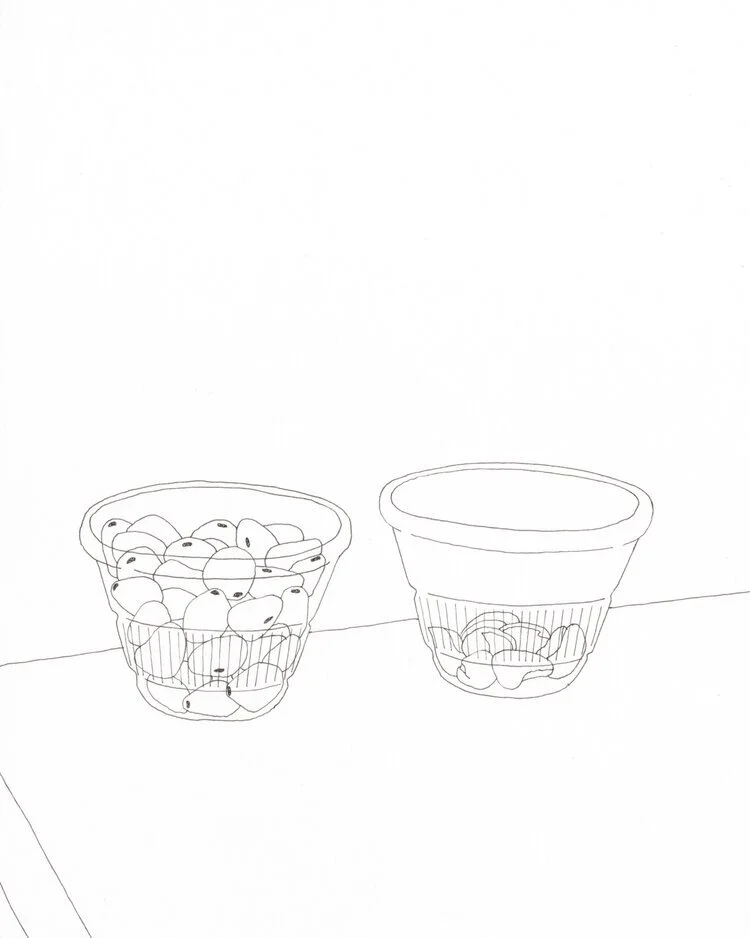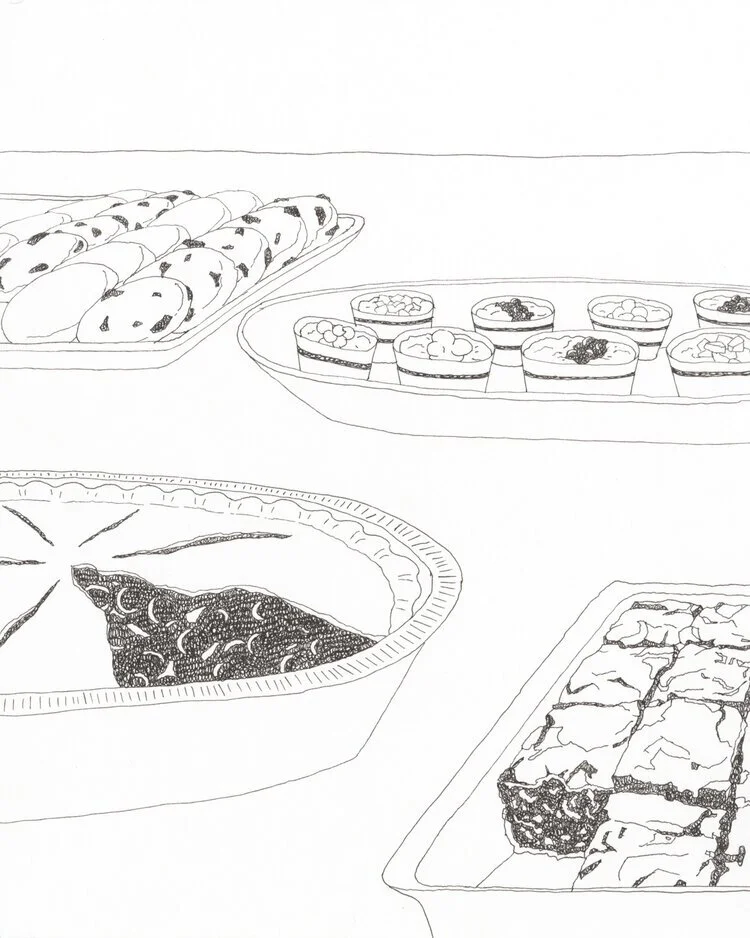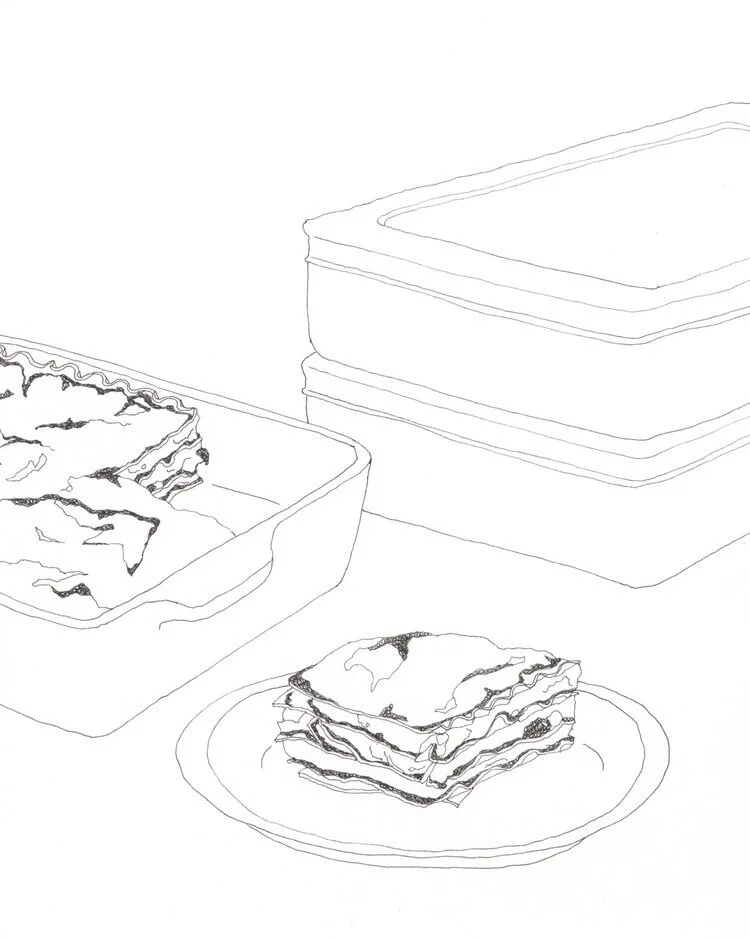What We Ate
This series of drawings and writings is a reflection on the journey of my mom getting sick and dying from cancer. I began this project in 2018, two years after my mom died, after reading Ilene Beckerman’s “Love, Loss, and What I Wore”. I realized that as Ilene’s memories of her early life were tied to her clothes, many of my memories around my mom’s illness and death were tied to food—given, received, eaten alone or together. It’s through food that our family and community connected and cared, tried to preserve life and continued living.
Mom and I talked on the phone and she told me she had a surprise for me. It was during the summer and she was in the hospital again, so Dad and I were going to visit her. When we arrived we went up to a very high floor. It was different from the ones Mom was usually on. Quiet, pristine, calm. Now looking back, Dad thinks it was an end-of-life unit. We got to Mom’s room and in her raspy, faint voice, now familiar, she exclaimed that she had saved me her fruit cup. I ate it from the plastic glass.
Auntie Cheryl was the first person I talked to, other than Mom and Dad, after they told me that the doctors couldn’t treat the cancer anymore. We talked on the phone; she was coming over our house that night and had eaten Cheetos. She told me then, and later when she was over, that she never ate Cheetos. But that night she did.
We all got the same soup for lunch that day from Au Bon Pain. They didn’t have many options so we all chose the Tuscan White Bean. We ate up in Mom’s room but didn’t finish, so we brought the rest home with us. Mom was wearing her patterned blue shirt with the beads around the neckline. We drove back with our leftover soup. Dad driving, Mom in the passenger seat, and Samantha and I in the back. It was our last car ride all together.
The four of us left the hospital, after staying there for three days. It was Mom’s final visit, and we didn’t even consider leaving her there alone. Everyone seemed to know at this point, that Mom was really sick, and we arrived home to baskets and bouquets of fruit and flowers. “Get well soon” wasn't appropriate anymore; people passed on other sentiments with their gifts. The Pereira’s gave us an Edible Arrangements fruit basket. I didn't like cantaloupe much, but I’d chip away at it, eating some with my breakfasts.
Mom asked for a burrito and I tried to find the ‘healthiest’ option. Even when she was dying—especially, really—I wanted Mom to eat the best food. I decided on a Red’s Chipotle Beef and Bean, and Mom asked me if I wanted to share it with her. I had just eaten lunch, but agreed anyway. We ate together, but Mom could tell I didn’t really want the burrito. She could read me better than anyone. I was honest with her; I really didn’t want to eat it, but wanted to do whatever I could to help her eat. She had to stop eating because it was too spicy. It would have upset her stomach.
I’d written down a list of items to buy from Market Basket that day, but I was mostly just looking for food Mom would eat. Her body was weak and I thought—if she ate more, maybe she’d live longer. Maybe she’d even get better. Walking down the aisle, I saw a big jar of glowing yellow lupini beans. They’d always been one of Mom’s favorite snacks. We knew them as one of those weird foods from her childhood that she liked to share with us. When I got home, I showed them to Mom. They were exactly what she wanted, she said. I served her some, more than she could eat. She shelled and ate them, and I sat with her, and hoped she’d keep eating.
I baked with the lavender cake pop maker, that I bought from Savers for a school assignment, the night Mom passed away. I was in the kitchen, two rooms from where she was. It was hard to be in the room, with her that last day. Samantha and Dad called me over and Mom was breathing heavily. She stopped. I made so many cake pop balls. Auntie Fil put them on the dessert table at the gathering at our house after Mom’s funeral.
We invited everyone over, and the house was over capacity for sure. Everyone brought food. There were tons of desserts, arranged by Mom’s colleagues and sisters on the dining table. We knew that we would eat them if we kept them, at least Dad and I would; we’re emotional eaters. Hannah stayed the whole time. We weren’t as close as we'd been years before, but she’d always be like my second sister. Hannah generously took home all of the desserts.
The love we were shown through food we were given was incredible and overwhelming. Of all that we were given, the most striking was the lasagnas. We were given so many, each from a different family. To be honest we didn’t even like lasagna. So we laughed. But it helped, having food already made so that we didn’t have to cook. Though sometimes it helped to cook. Dad ate more of the lasagnas than Samantha or I.
See more of Christina's work at christinastrachoff.com









